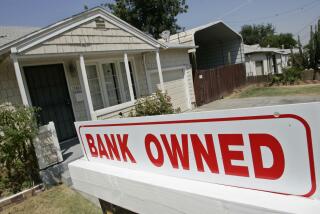Fast Payoff of Mortgage Saves Bundle in Interest
- Share via
Question: I was interested in a column you did recently on accelerating mortgage payments on your home and saving a bundle in interest. Like the person who wrote you, I’ve been getting all sorts of static from my friends about how dumb it is (because I could be investing those over-payments), but I’m not convinced either.
I figure this would be a good resolution to make starting in ‘86, but I’d like a little reinforcement and also need some advice on a practical way of going about this acceleration so that there’s some system to it. I don’t want to just guess about how much I should be paying extra every month. On one point, at least, I guess my friends are right: You sharply reduce how much you can deduct for taxes by doing this, don’t you?--T.R.
Answer: Sure you do, but it’s a matter of priorities. Even if by accelerating your mortgage payments you cut your payoff time down from 30 to 15 years, you’re still going to have an appreciable deductibility for most of those 15 years.
The old “why prepay when you can invest this difference instead” argument can’t be entirely discounted, of course, even though it doesn’t nearly make the sense that it did a few short years ago when, instead of accelerating the payment on an 11% mortgage, you could invest those funds in a money-market fund yielding 14%. Today, of course, the yield on a money-market fund (7%-8%) is comparable to the return you can get on a conventional bank time deposit, and fixed-rate mortgages remain stubbornly high in the 12%-13% range.
But to give the devil his due, let’s take an example of what your friends are talking about: You’ve just taken on a $100,000, 30-year mortgage (fixed rate) at 13%. This makes your payments roughly $1,107 a month. At the end of 30 years, then, you will have paid your lender $398,520, of which a full $298,520 is interest only.
Other Side of the Coin
Accelerating your payments to pay off the same indebtedness, $100,000, in 15 years instead of 30, would mean increasing the monthly payments 14% (or $159) to $1,266. At the end of 15 years you will have paid your lender $227,880, $127,880 of it in interest only, for a net savings in interest of $170,640.
But here’s the other side of that coin: Instead of accelerating your monthly payments, you stick with your 30-year amortization schedule, pay $1,107 a month and invest that extra $159 in something productive. For instance: a tax-exempt municipal bond fund yielding 8%. At the end of 15 years--I suspect that your friends are telling you--you could then cash in this fund and pay off the remaining balance.
But it doesn’t quite work that way.
At the end of 15 years, your $159-a-month investment (compounded quarterly) would have grown to $55,126, a nice nest egg, but still not enough to pay off the mortgage. Meanwhile, during those 15 years, you’ve already paid your lender $199,260, or, at the halfway point, almost twice the amount you originally borrowed.
Admittedly, during those 15 years, you will have been able to deduct considerably more from your taxes for interest expense than you did by accelerating your monthly payments, which will distort the net cost.
The other side of this coin, however, is the proposed changes in the Tax Code now being pondered by Congress, and if the anticipated lower rates for individuals come into play, you’ll have still another distortion built in--one that will reduce the desirability of those interest-rate deductions in which your friends put such faith.
But all of this is pretty academic as soon as someone like you begins thinking in terms of how unproductive it is--as long as he can afford it--to pay a lender over 30 years a fat $298,520 for the privilege of using his $100,000 during that time.
Now for the other aspect of your question: How do you go about it?
There are two popular approaches, but the easier, by far, is simply to go to your local stationery shop and buy a paperback mortgage-payment guide, which gives a tabular rundown of the monthly payments (principal and interest) required to amortize various mortgages (by dollar amount) at different interest rates, year by year, from one year to 35 or 40 years.
Let’s say that you’re winding up your third year paying on a 30-year, 13% mortgage for $100,000. What you’ll want to do, first, is to go back to the last year-end statement from your lender detailing how much in principal and interest you paid during the previous year and what the outstanding balance was at the beginning of the current year.
Don’t be surprised to discover that after three years of paying your lender $1,107 a month--$13,284 a year--you still owe slightly more than $99,000 of the original $100,000 (you’ll be about 25 or 26 years along on the standard 30-year mortgage before your monthly payments begin going 50 50 toward principal and interest.)
Now, if you want to wind the whole thing up in half the time (that would be in another 12 years because you are already three years into it), you would run your finger down the 12-year column in your mortgage guide and find that you must increase your payments to $1,375 a month--$268 more per month than your present payments--to attain it.
But that’s a pretty big jump, and Boston-based Financial Publishing Co., a major publisher of amortization schedules and other financial material for lenders, has long advocated another method of prepayment that is relatively painless for at least the first few years of acceleration. The plan simply entails writing two checks a month--one for your standard principal interest payment and a second for the next month’s principal payment only.
Obviously, in order to implement such a plan, it’s necessary to have at hand a computer printout, month by month, of the breakdown of how much of your monthly payment is going to principal and how much is going to interest. Some lenders are obliging enough to perform this service for you; others are a little testy on the subject.
You can, however, obtain such a printout from Financial Publishing Co., 82 Brookline Ave., Boston, Mass. 02215 for $10. You’ll have to supply the company with the following information: the original terms of your mortgage (gross amount, the interest rate and your monthly payments--but excluding any monthly amounts also deducted for such items as impounds for insurance or taxes). You’ll also have to supply them with data as to exactly where you are now on your timetable.
For instance: You made your first payment on your mortgage in February, 1982, and so, sometime in the next few days, you’ll be making your 59th monthly payment.
Here is an illustrative example that Financial Publishing uses in demonstrating how this acceleration strategy works on a brand-new $50,000 mortgage for 30 years at 13% (360 payments in all), with monthly payments for principal and interest totaling $553.10:
Payment Interest Principal Loan Balance 1 $541.67 $11.43 $49,988.57 2 $541.54 $11.56 $49,977.01 3 $541.42 $11.68 $49,965.33 4 $541.29 $11.81 $49,953.58 5 $541.16 $11.94 $49,941.58
And so on to the final 360th payment. With the home buyer’s first $553.10 payment, he includes a second check marked “Principal Only,” in the amount of $11.56, representing the principal due the second month, which has the practical effect of reducing the length of his mortgage by one full, additional month--not from 360 payments to 359, but from 360 to 358.
With his second monthly check of $553.10, he includes a second check in the amount of $11.68 (the third month) and so on until, in the 15th year, he’s completely paid it off.
Yes, naturally, the acceleration is such that in a very few years that extra “principal only” payment every month is going to stop being a nickel-and-dime affair and, in about seven or eight years, is going to equal and then exceed his regular monthly payment. But even if he has to cut back to a more modest acceleration schedule at that time (rounding it, we’ll say, to a simple $100-extra-a-month payment), he’s saved a pot in interest charges and has dramatically shortened the length of his indebtedness.
Those are the mechanics of accelerating a mortgage. The willpower to do it is something you’re going to have to come up with yourself.
More to Read
Inside the business of entertainment
The Wide Shot brings you news, analysis and insights on everything from streaming wars to production — and what it all means for the future.
You may occasionally receive promotional content from the Los Angeles Times.










